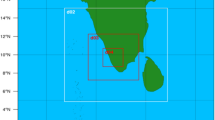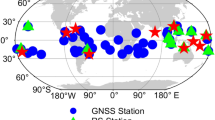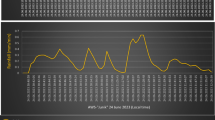Abstract
Storm is a convective cell much smaller than a mesoscale convective system (MCS) but typically larger than a cumulonimbus cloud and heavy precipitation and lightning are often associated with it. Storms contribute major fraction of the convective precipitation in MCSs. Storm characteristics and precipitation estimates around New Delhi (28.6°N, 77.2°E; an Indian land location) during June–September period of the year 2013 are reported here using data of C-band polarimetric Doppler weather radar. Storms, defined based on radar reflectivity thresholds (30 dBZ for simple storms and 40 dBZ for intense storms), are tracked and their properties are extracted. Our results show that about 80% of storms exist for 1 h or less. The areas of 90% of simple storms are less than 100 km2 and the largest area averaged over storm lifespan does not exceed 400 km2. The majority of storms (> 80%) move with speeds less than 30 km h−1. About 60–65% of simple/intense storms have echo top heights between 6 and 10 km, while only few of them exceed 17 km. The values of average thickness of simple and intense storms lie between ~ 2–10 and ~ 1–7 km, respectively. It is not the vertical extent of a storm but its area-time integral that correlates better with the total precipitation amount. Around the New Delhi area, daily accumulated precipitation derived from relations incorporating polarimetric variables is in good agreement with the rain gauge measurements while that obtained from relations based on radar reflectivity factor (Zh) alone highly underestimates precipitation. This suggests that polarimetric capability is needed in Doppler weather radars to get the realistic precipitation estimates. The mean precipitation water content derived from Zh (~ 0.96 g m−3) is about 30–40% less compared to that derived from polarimetric relations. Our findings on storm properties have implications for cloud parameterizations and in short-term weather forecasting.










Similar content being viewed by others
References
Biggerstaff MI, Listemaa SA (2000) An improved scheme for convective/stratiform echo classification using radar reflectivity. J. Appl Meteorol 39:2129–2150
Booker HG (1946) Elements of radio meteorology: how weather and climate cause unorthodox radar vision beyond the geometrical horizon. Elect Eng - Part I 93:69–78
Brandes EA, Ryzhkov AV, Zrnić DS (2001) An evaluation of radar rainfall estimates from specific differential phase. J Atmos Ocean Technol 18:363–375
Bringi VN, Chandrasekar V (2001) Polarimetric Doppler weather radar principles and applications, 2nd edn. Cambridge Univ Press, New York, p 390 Ch8, 537-545
Caine S, Lane TP, May PT, Jakob C, Siems ST, Manton MJ, Pinto J (2013) Statistical assessment of tropical convection-permitting model simulations using a cell-tracking algorithm. Mon Weather Rev 141:557–581
Chatterjee RN, Prakash P, Ali K (1991) Frequency distribution of the heights of convective clouds in different regions of India. Atmos Res 26:445–454
CTCZ (2009) Continental tropical convergence zone (CTCZ) programme science plan. Available online at http://www.odisincoisgovin/images/ctczimages/docs/science_plan.pdf. Accessed 23 July 2013
Dixon M (2014) Radx C++ software package for radial radar data. Available online at http://www.ralucaredu/projects/titan/docs/radial_formats/radx.html. Accessed 16 Aug 2015
Dixon M, Wiener G (1993) TITAN: thunderstorm identification, tracking, analysis, and nowcasting -a radar-based methodology. J Atmos Ocean Technol 10:785–797
Donaldson RJ (1970) Vortex signature recognition by a Doppler radar. J Appl Meteorol 9:661–670
Doneaud AA, Niscov SI, Priegnitz DL, Smith PL (1984) The area-time integral as an indicator for convective rain volumes. J Clim Appl Meteorol 23:555–561
Doviak RJ, Zrnić DS (1993) Doppler radar and weather observations, 2nd edn. Academic Press, San Diego, p 562
Feng G, Qie XS, Yuan T, Niu SZ (2007) Lightning activity and precipitation structure of hailstorms. Sci China Ser D 50:629–639
Ghosh BB (1967) A radar study on thunderstorms and convective clouds around New Delhi during the southwest monsoon season. Indian J Meteorol Geophys 18:391–396
Goudenhoofdt E, Delobbe L (2013) Statistical characteristics of convective storms in Belgium derived from volumetric weather radar observations. J Appl Meteorol Climatol 52(918):934. https://doi.org/10.1175/JAMC-D-12-079.1
Greene DR, Clark RA (1972) Vertically integrated liquid water-A new analysis tool. Mon Wea Rev 100:548–552
Houze RA (2004) Mesoscale convective systems. Rev Geophys 42:RG4003. https://doi.org/10.1029/2004RG000150
Houze RA, Cheng C (1977) Radar characteristics of tropical convection observed during GATE: mean properties and trends over the summer season. Mon Weather Rev 105:964–980
Houze RA, Wilton DC, Smull BF (2007) Monsoon convection in the Himalayan region as seen by the TRMM precipitation radar. Q J R Meteorol Soc 133:1389–1411
Houze RA, Rasmussen KL, Zuluaga MD, Brodzik SR (2015) The variable nature of convection in the tropics and subtropics: A legacy of 16 years of the Tropical Rainfall Measuring Mission satellite. Rev Geophys 53:994–1021. https://doi.org/10.1002/2015RG000488
Hunter SM (1996) WSR-88D radar rainfall estimation: capabilities, limitations and potential improvements. Nat Weather Dig 20:26–38 Available online at http://www.nw-asorg/digest/papers/1996/Vol20No4/Pg26-Hunterpdf. Accessed 15 April 2014
Iguchi T et al (2000) Rain-profiling algorithm for the TRMM precipitation radar. J Appl Meteorol 39:2038–2052
IMD report (2011) Standard operating procedure for Doppler weather radar-98D/S. http://www.metnetimdgovin/projects_doc/sop_dwr.pdf. Accessed 20 July 2013
Kummerow C, Barnes W, Kozu T, Shiue J, Simpson J (1998) The tropical rainfall measuring mission (TRMM) sensor package. J Atmos Ocean Technol 15:15809–15817
Lee GW, Seed AW, Zawadzki I (2007) Modeling the variability of drop size distributions in space and time. J Appl Meteorol Climatol 46:742–756
Liu C, Cecil DJ, Zipser EJ, Kronfeld K, Robertson R (2012) Relationships between lightning flash rates and radar reflectivity vertical structures in thunderstorms over the tropics and subtropics. J Geophys Res 117:D06212. https://doi.org/10.1029/2011JD017123
Marshall JS, Palmer WMK (1948) The distribution of raindrops with size. J Meteorol 5:165–166
Massey FJ (1951) The Kolmogorov-Smirnov test for goodness of fit. J Am Stat Assoc 46:68–78
Morwal SB et al (2012) Cloud microphysical properties over Indian monsoon regions during CAIPEEX-2009. J Atmos Sol Terr Phys 81-82:76–85
Novo S, Martínez D, Puentes O (2014) Tracking, analysis, and nowcasting of Cuban convective cells as seen by radar. Meteorol Appl 21:585–595
Potts RJ, Keenan TD, May PT (2000) Radar characteristics of storms in the Sydney area. Mon Weather Rev 128:3308–3319
Raghavan S (2003) Radar meteorology: Ch. 7. Estimation of precipitation. Kluwer Academic Publishers, the Netherlands, pp 261–312
Rogers RR, Yau MK (1989) A short course in cloud physics. Butterworth Heinemann. An imprint of Elsevier, p 183
Ryzhkov AV, Zrnić DS (1996) Assessment of rainfall measurement that uses specific differential phase. J Appl Meteorol 35:2080–2090
Sachidananda M, Zrnić DS (1987) Rain rate estimates from differential polarization measurements. J Atmos Ocean Technol 4:588–598
Seshadri N (1963) A radar study of heights of tops of cumulonimbus clouds around New Delhi. Indian J Meteorol Geophys 14:46–49
Shah S, Notarpietro R, Branca M (2015) Storm identification, tracking and forecasting using high-resolution images of short-range X-band radar. Atmosphere 6:579-606
Sindhu KD, Bhat GS (2018) Characteristics of monsoonal precipitating cloud systems over the Indian subcontinent derived from weather radar data. Q J R Meteorol Soc 144:1742–1760
Utsav B, Deshpande SM, Das SK, Pandithurai G (2017) Statistical characteristics of convective clouds over the Western Ghats derived from weather radar observations. J Geophys Res Atmos 122:10050–10076
Wang Y, Chandrasekar V (2009) Algorithm for estimation of the specific differential phase. J Atmos Ocean Technol 26:2565–2578
WMO (2005) Training course on weather radar systems. WMO RMTC Turkey. https://www.wmo.int/pages/prog/www/IMOP/publications/IOM-88_TM-Radars/IOM-88_Module-D.pdf. Accessed 2 Oct 2013
Zipser EJ, Lutz KR (1994) The vertical profile of radar reflectivity of convective cells: a strong indicator of storm intensity and lightning probability? Mon Weather Rev 122:1751–1759
Zipser EJ, Cecil D, Liu C, Nesbitt S, Yorty D (2006) Where are the most intense thunder storms on earth? Bull Am Meteorol Soc 87:1057–1071
Acknowledgements
Authors thank IMD and the CTCZ program of the Ministry of Earth Sciences, Government of India, New Delhi (India) for providing DWR and Kalpana-1 satellite data. Authors thank Mr. Michael J. Dixon, UCAR for his valuable discussion regarding radar data processing using the Radx-algorithm.
Author information
Authors and Affiliations
Corresponding author
Additional information
Publisher’s note
Springer Nature remains neutral with regard to jurisdictional claims in published maps and institutional affiliations.
Electronic supplementary material
ESM 1
(DOCX 1415 kb)
Rights and permissions
About this article
Cite this article
Sindhu, K.D., Bhat, G.S. Storm characteristics and precipitation estimates of monsoonal clouds using C-band polarimetric radar over Northwest India. Theor Appl Climatol 138, 237–248 (2019). https://doi.org/10.1007/s00704-019-02828-6
Received:
Accepted:
Published:
Issue Date:
DOI: https://doi.org/10.1007/s00704-019-02828-6




